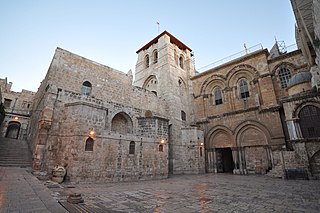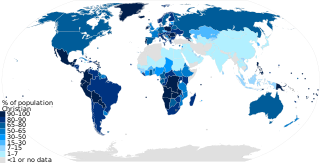
Christianity is an Abrahamic monotheistic religion based on the life and teachings of Jesus of Nazareth. It is the world's largest and most widespread religion with roughly 2.4 billion followers representing one-third of the global population. Its adherents, known as Christians, are estimated to make up a majority of the population in 157 countries and territories. They believe that Jesus is the Son of God, whose coming as the Messiah was prophesied in the Hebrew Bible and chronicled in the New Testament.

Christendom historically refers to the Christian states, Christian empires, Christian-majority countries and the countries in which Christianity dominates, prevails, or that it is culturally or historically intertwined with.

The history of Christianity concerns the Christian religion, Christian countries, and the Christians with their various denominations, from the 1st century to the present. Christianity originated with the ministry of Jesus, a Jewish teacher and healer who proclaimed the imminent Kingdom of God and was crucified c. AD 30–33 in Jerusalem in the Roman province of Judea. His followers believe that, according to the Gospels, he was the Son of God and that he died for the forgiveness of sins and was raised from the dead and exalted by God, and will return soon at the inception of God's kingdom.

In the history of Europe, the Middle Ages or medieval period lasted approximately from the late 5th to the late 15th centuries, aligning with the post-classical period of global history. It began with the fall of the Western Roman Empire in 476 AD and ended with the fall of Constantinople in 1453 AD before transitioning into the Renaissance and then the Age of Discovery. The Middle Ages is the middle period of the three traditional divisions of Western history: antiquity, medieval, and modern. The medieval period is itself subdivided into the Early, High, and Late Middle Ages. Late medieval scholars at first called these the Dark Ages in contrast to classical antiquity; the accuracy of the term has subsequently been challenged.

Eastern Christianity comprises Christian traditions and church families that originally developed during classical and late antiquity in Western Asia, Asia Minor, Eastern Europe, Southeastern Europe, the Caucasus, Northeast Africa, the Fertile Crescent and the Malabar coast of South Asia, and ephemerally parts of Persia, Central Asia and the Far East. The term does not describe a single communion or religious denomination.
Religious nationalism can be understood in a number of ways, as nationalism as a religion itself, a position articulated by Carlton Hayes in his text Nationalism: A Religion or as the relationship of nationalism to a particular religious belief, dogma, ideology or affiliation. This relationship can be broken down into two aspects: the politicisation of religion and the influence of religion on politics.

In ecclesiology, the Christian Church is what different Christian denominations conceive of as being the true body of Christians or the original institution established by Jesus. "Christian Church" has also been used in academia as a synonym for Christianity, despite the fact that it is composed of multiple churches or denominations, many of which hold a doctrinal claim of being the "one true church", to the exclusion of the others.

The Early Middle Ages, sometimes controversially referred to as the Dark Ages, is typically regarded by historians as lasting from the late 5th or early 6th century through the 10th century. They marked the start of the Middle Ages of European history, following the decline of the Western Roman Empire, and preceding the High Middle Ages. The alternative term late antiquity, for the early part of the period, emphasizes elements of continuity with the Roman Empire, while Early Middle Ages is used to emphasize developments characteristic of the earlier medieval period. The time between the 8th and 11th centuries is assigned to the Early Middle Ages generally, even by those who extend (late) antiquity to a time well after the 5th century.
The Western religions are the religions that originated within Western culture, which are thus historically, culturally, and theologically distinct from Eastern, African and Iranian religions. The term Abrahamic religions is often used instead of using the East and West terminology, as these originated in the Middle East.

During the reign of the Roman Emperor Constantine the Great, Christianity began to transition to the dominant religion of the Roman Empire. Historians remain uncertain about Constantine's reasons for favoring Christianity, and theologians and historians have often argued about which form of early Christianity he subscribed to. There is no consensus among scholars as to whether he adopted his mother Helena's Christianity in his youth, or, as claimed by Eusebius of Caesarea, encouraged her to convert to the faith he had adopted.

Christianity is the largest religion in Europe. Christianity has been practiced in Europe since the first century, and a number of the Pauline Epistles were addressed to Christians living in Greece, as well as other parts of the Roman Empire.

Christianity in Asia has its roots in the very inception of Christianity, which originated from the life and teachings of Jesus in 1st-century Roman Judea. Christianity then spread through the missionary work of his apostles, first in the Levant and taking roots in the major cities such as Jerusalem and Antioch. According to tradition, further eastward expansion occurred via the preaching of Thomas the Apostle, who established Christianity in the Parthian Empire (Iran) and India. The very First Ecumenical Council was held in the city of Nicaea in Asia Minor (325). The first nations to adopt Christianity as a state religion were Armenia in 301 and Georgia in 327. By the 4th century, Christianity became the dominant religion in all Asian provinces of the Eastern Roman Empire.

Christians are people who follow or adhere to Christianity, a monotheistic Abrahamic religion based on the life and teachings of Jesus Christ. The words Christ and Christian derive from the Koine Greek title Christós (Χριστός), a translation of the Biblical Hebrew term mashiach (מָשִׁיחַ). While there are diverse interpretations of Christianity which sometimes conflict, they are united in believing that Jesus has a unique significance. The term Christian used as an adjective is descriptive of anything associated with Christianity or Christian churches, or in a proverbial sense "all that is noble, and good, and Christ-like." It does not have a meaning of 'of Christ' or 'related or pertaining to Christ'.

In the 9th century, Christianity was spreading throughout Europe, being promoted especially in the Carolingian Empire, its eastern neighbours, Scandinavia, and northern Spain. In 800, Charlemagne was crowned as Holy Roman Emperor, which continued the Photian schism.

The Eastern Roman (Byzantine) imperial church headed by Constantinople continued to assert its universal authority. By the 13th century this assertion was becoming increasingly irrelevant as the Eastern Roman Empire shrank and the Ottoman Turks took over most of what was left of the Byzantine Empire. The other Eastern European churches in communion with Constantinople were not part of its empire and were increasingly acting independently, achieving autocephalous status and only nominally acknowledging Constantinople's standing in the Church hierarchy. In Western Europe the Holy Roman Empire fragmented making it less of an empire as well.

Christianity in the Middle Ages covers the history of Christianity from the fall of the Western Roman Empire. The end of the period is variously defined. Depending on the context, events such as the conquest of Constantinople by the Ottoman Empire in 1453, Christopher Columbus's first voyage to the Americas in 1492, or the Protestant Reformation in 1517 are sometimes used.
Christianity became the official religion of the Roman Empire when Emperor Theodosius I issued the Edict of Thessalonica in 380, which recognized the catholic orthodoxy of Nicene Christians in the Great Church as the Roman Empire's state religion. Most historians refer to the Nicene church associated with emperors in a variety of ways: as the catholic church, the orthodox church, the imperial church, the imperial Roman church, or the Byzantine church, although some of those terms are also used for wider communions extending outside the Roman Empire. The Eastern Orthodox Church, Oriental Orthodoxy, and the Catholic Church all claim to stand in continuity from the Nicene church to which Theodosius granted recognition.

A Christian state is a country that recognizes a form of Christianity as its official religion and often has a state church, which is a Christian denomination that supports the government and is supported by the government.

Christian culture generally includes all the cultural practices which have developed around the religion of Christianity. There are variations in the application of Christian beliefs in different cultures and traditions.

Arab nationalism is a political ideology asserting that Arabs constitute a single nation. As a traditional nationalist ideology, it promotes Arab culture and civilization, celebrates Arab history, glorifies the Arabic language as well as Arabic literature, and calls for the rejuvenation of Arab society through total unification. It bases itself on the premise that the people of the Arab world — from the Atlantic Ocean to the Indian Ocean — constitute one nation bound together by a common identity: ethnicity, language, culture, history, geography, and politics.

















